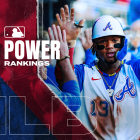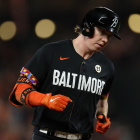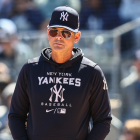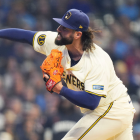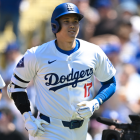
The Baseball Hall of Fame officially has an empty 2021 class. There will be a ceremony this coming summer in Cooperstown to celebrate the 2020 class, however, it'll just be a year late. This marks the first empty BBWAA class since 2013, bookending a stretch where the Hall added 22 players via the BBWAA vote and five more via veterans committees.
For years we've seen it: Adding lots of names to the Hall of Fame seems to make some people angry. That means that with no new members this voting cycles, there's bound to be rejoicing that the so-called "Hall of the Very Good" isn't getting more watered down!
Of course, that will be mitigated by the number of players making impressive gains and ultimately making progress toward making the Hall. As usual, there are a large number of people saying some misguided things. Let's blow those up with our fifth annual Hall of Fame version of mythbusters.
We have three items on our agenda.
[NOTE: This has been freshened and updated from the previous versions]
1. 'How can a player's vote total change?'
This question gets asked by two groups of people. The first is full of casual fans who are genuinely curious and just don't know. That's OK, too, as I'm here to explain. The second group is condescendingly trying to look down at the voting body for changing vote totals when the players aren't actually playing games. It's full of people who love to complain about "the media" as if every member is the same and it's not simply a profession made up of individuals with different opinions like every other job on the planet. I've heard Curt Schilling himself -- who barely missed the cut this time around -- mockingly say stuff like "I haven't won another game, I haven't thrown another pitch ... "
To Curt and everyone on that side, you're either being misled or are willfully ignorant.
The ballot changes every year and there is a 10-vote maximum.
Knowing this, it should be pretty easy to grapple with the fact that vote totals are going to change on a yearly basis.
Let's walk through what my ballot would have been last year vs. this year as an illustration.
For the 2020 ballot, I had down the maximum of 10 names: Barry Bonds, Roger Clemens, Derek Jeter, Curt Schilling, Sammy Sosa, Gary Sheffield, Larry Walker, Scott Rolen, Todd Helton and Andruw Jones.
From that ballot, Jeter and Walker were cleared by virtue of making the Hall of Fame. I didn't change my eight holdovers for this year. I did add Billy Wagner. I also considered Jeff Kent, Bobby Abreu and Tim Hudson and Mark Buehrle.
Now, how did I add Wagner to my ballot when he hasn't thrown a pitch? We all know the answer. I didn't have room before but this time I did.
In the past, we've seen stuff like five worthy players clearing the ballot in one fell swoop. That clears spots for holdovers to gain support. Sometimes, it goes the other way and a group of worthy players joins the ballot, which means some of the marginal vote-getters would lose support.
That's mainly how vote totals fluctuate, but there's also the simple and honest changing of minds. At first glance of Scott Rolen, for example, I didn't think he was a Hall of Famer. After years of researching on my own and also reading the thoughts of people whose opinions I greatly respect, I have changed my mind. He's not toward the top of my list, but I firmly believe he is rightfully being championed and when he gets enshrined, it will be a well-deserved honor.
That's allowed! It's also surely part of why the players get 10 -- and used to get 15 -- years on the ballot. Some don't enjoy the process, but I quite enjoy debating the merits of possible Hall of Famers each winter. Respectful debate can be good and it definitely is when it comes to worthy players like Larry Walker, Tim Raines, Edgar Martinez and Bert Blyleven getting into the Hall of Fame.
2. 'The Hall of Fame got too watered down'
These people are rejoicing this year with an empty class, but they are misguided.
With 27 players being added to the Hall in the previous seven voting cycles, things have gone a bit off the rails in the sector of public opinion. So let's dive in. Did the Hall "become too watered down" this last decade or so?
In short: Nope. I'm going to assume the people saying this don't really know enough about how many players are actually in the Hall of Fame. The people saying this seem to believe it's only the inner-circle all-time greats like Babe Ruth, Hank Aaron, Willie Mays, Jackie Robinson et al.
Given that thought process, it's easy to see why these people would fret about the votes since the empty one in 2013. In 2014, Greg Maddux, Tom Glavine and Frank Thomas got in. In 2015, it was a four-man class with Craig Biggio, John Smoltz, Pedro Martinez and Randy Johnson. The 2016 class featured Ken Griffey and Mike Piazza, with 2017 putting in Jeff Bagwell, Tim Raines and Ivan Rodriguez. The following year it was another four-man class with Chipper Jones, Vladimir Guerrero, Jim Thome and Trevor Hoffman getting in. During this time, Jack Morris, Alan Trammell, Harold Baines and Lee Smith were added via veterans committees. In 2019, we added four more in Mariano Rivera, Roy Halladay, Mike Mussina and Edgar Martinez. The 2020 class has Ted Simmons, Derek Jeter and Larry Walker joining the fray in a delayed ceremony this summer. As previously mentioned, that's 27 players in seven classes and Small Hall people couldn't have been thrilled. They are on Cloud Nine now!
Aside from the dubious selection of Baines and questionable selection of Morris -- and a case could be made against Smith -- everyone else above belongs in the Hall based upon the established standard.
It's true that the 2014-20 run by the BBWAA vote was historic. Since the original class of five inductees in 1936 (Ty Cobb, Honus Wagner, Babe Ruth, Christy Mathewson and Walter Johnson, for those curious), the only four-man classes were 1947 and 1955 until this recent run. The BBWAA put through four-man classes in 2015, 2018 and 2019. Heck, there were only seven three-man classes until 2014 and 2017 were added to the list.
With the floodgates seemingly open, the "becoming too watered down" argument thrived among the uninformed. To illustrate how this opinion is uninformed, let's take a look at the Hall of Famers by the decade in which they debuted (with a hat-tip to YES researcher James Smyth). This is the percentage of MLB players with at least 5,000 plate appearances or 2,000 innings pitched that are in the Hall of Fame, sorted by the decade in which they first appeared in the majors.
pre-1900: 23.5 percent
1900-09: 20.3
1910s: 23.2
1920s: 35.6
1930s: 19.5
1940s: 22.4
1950s: 21.2
1960s: 14.4
1970s: 10.7
1980s: 10.3
1990s: 7.4
Becoming watered down? "Why don't they just let everyone in?" C'mon. The degree of difficulty to make the Hall of Fame has never been higher. Sure, the 1990s are likely going to catch up a little in the next several years, but it's been more than three times as hard for a player who debuted in the 1970s than those who debuted in the 1920s to make the Hall. For those who first tasted the bigs in the '80s it's even worse.
Again, I think a large number of the people peddling this incorrect argument just don't know how many people are in the Hall of Fame.
It isn't just Walter Johnson, Sandy Koufax, Greg Maddux, Pedro Martinez and Tom Seaver. It's also Eppa Rixey, Jack Chesbro, Waite Hoyt, Addie Joss and Herb Pennock.
It isn't just Aaron, Ruth, Mays and Mantle. It's also Chick Hafey, Hugh Duffy, Max Carey and Sam Thompson.
Now, a large number of people might argue that it should only be the former list of players and not the latter, but that's not how it works. We don't get to decide now what we want it to be. There's an established standard.
It should go without saying, but let's be clear here: This stance doesn't mean we should put in every player who is better than the worst Hall of Famer. That would be ridiculous. The task now is to bring up the standard. Only induct players who are better than the average Hall of Famer (this is where JAWS/WAR sorting comes in handy, even if it should never be used as a hard-and-fast rule). Every BBWAA entry listed above brings up the standard.
One final note: Being in or out of the Hall of Fame doesn't need to determine how we remember who were the best players of all-time. Anyone who follows baseball and studies its history knows how much better Mike Schmidt was than Scott Rolen. That doesn't automatically disqualify Rolen just as Rolen making the Hall wouldn't somehow cheapen Schmidt's accomplishments.
3. 'If you can't tell the story of baseball without him, he should be in'
This is the argument I see peddled in favor of our top three guys who missed out this voting cycle in Curt Schilling, Barry Bonds and Roger Clemens. It could be applied to others on the ballot like Manny Ramirez and Sammy Sosa. And, in next year's vote, it could be applied to those who support the candidacy of Alex Rodriguez.
This argument surely comes from someone who has never been to the Hall of Fame (and that's OK!). There are several areas that tell the story of baseball and have exhibits for records, such as those held by Barry Bonds (here's an online exhibit) and Pete Rose (look in here for proof). If someone doesn't believe Bonds deserves to experience the enshrinement and getting his own bust for whatever reason, the above quote isn't a proper response. There's still mention of Bonds in the museum.














